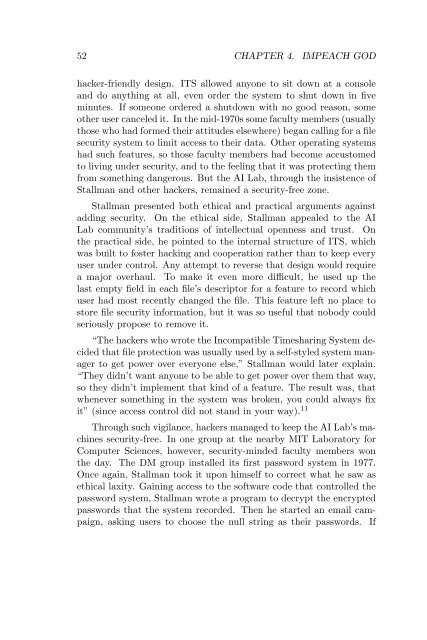You also want an ePaper? Increase the reach of your titles
YUMPU automatically turns print PDFs into web optimized ePapers that Google loves.
52 CHAPTER 4. IMPEACH GOD<br />
hacker-friendly design. ITS allowed anyone to sit down at a console<br />
and do anything at all, even order the system to shut down in five<br />
minutes. If someone ordered a shutdown with no good reason, some<br />
other user canceled it. In the mid-1970s some faculty members (usually<br />
those who had formed their attitudes elsewhere) began calling for a file<br />
security system to limit access to their data. Other operating systems<br />
had such features, so those faculty members had become accustomed<br />
to living under security, and to the feeling that it was protecting them<br />
from something dangerous. But the AI Lab, through the insistence of<br />
Stallman and other hackers, remained a security-free zone.<br />
Stallman presented both ethical and practical arguments against<br />
adding security. On the ethical side, Stallman appealed to the AI<br />
Lab community’s traditions of intellectual openness and trust. On<br />
the practical side, he pointed to the internal structure of ITS, which<br />
was built to foster hacking and cooperation rather than to keep every<br />
user under control. Any attempt to reverse that design would require<br />
a major overhaul. To make it even more difficult, he used up the<br />
last empty field in each file’s descriptor for a feature to record which<br />
user had most recently changed the file. This feature left no place to<br />
store file security information, but it was so useful that nobody could<br />
seriously propose to remove it.<br />
“The hackers who wrote the Incompatible Timesharing System decided<br />
that file protection was usually used by a self-styled system manager<br />
to get power over everyone else,” Stallman would later explain.<br />
“They didn’t want anyone to be able to get power over them that way,<br />
so they didn’t implement that kind of a feature. The result was, that<br />
whenever something in the system was broken, you could always fix<br />
it” (since access control did not stand in your way). 11<br />
Through such vigilance, hackers managed to keep the AI Lab’s machines<br />
security-free. In one group at the nearby MIT Laboratory for<br />
Computer Sciences, however, security-minded faculty members won<br />
the day. The DM group installed its first password system in 1977.<br />
Once again, Stallman took it upon himself to correct what he saw as<br />
ethical laxity. Gaining access to the software code that controlled the<br />
password system, Stallman wrote a program to decrypt the encrypted<br />
passwords that the system recorded. Then he started an email campaign,<br />
asking users to choose the null string as their passwords. If


